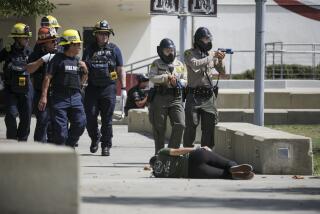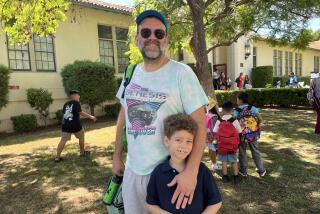SANTA ANA : Lifesaving Skills Tested by Students
Wearing a stethoscope around his neck and an orange vest, Eddie Alvarez, 18, scrambled to find the wounded and dying during a realistic disaster drill on Tuesday that turned the Santa Ana High School gym into a massive emergency shelter.
Alvarez was one of 16 students trained in an American Red Cross-sponsored program that teaches how to conduct critical life-saving emergency services after a major disaster. Students were taught such services as setting up mass first-aid stations, performing triage, and identifying and registering victims. Dozens of other students in a biomedical science class played injured victims throughout the two-hour exercise.
Alvarez said the drill helped to point out what the team needed to improve, but he added that a real disaster would be the critical test. âWe just donât know how weâll be, emotionally, when it really happens. I donât think weâll be this organized.â
He also said that he was surprised by the enormity of the task âbecause you didnât expect them to be that injured.â
As he returned carrying a student posing as an unconscious heart attack victim on a stretcher, dozens of other students with arm splints and blood-stained head bandages limped into the gym seeking help. Students wore tags that identified what kind of injury they sustained, and several students wore tags that read âemotional,â signifying that they had no injuries but were still in shock.
The injury victims were guided to green cots in one corner of the gym, while others in more critical need of help received instant first aid. The disaster response team members made a point of separating the wailing emotional victims from the others in order to maintain a sense of calm.
Swathed in bandages, Raul Martinez, 16, feigned a head injury. Although he said the drill was fun, he added that it also made him a little nervous because âitâs like the real thing.â
Rosa Sanchez, 17, said the exercise showed âwhat can really happen during a real disaster. Today we were really calm, but once you have people who are really injured and who you have to help, then you really have to watch what youâre doing.â
Judy Iannaccone, spokeswoman for the Orange County chapter of the Red Cross, said the training is important because in a real emergency many of the shelters will be set up in high schools, where students trained in emergency response will be waiting. Also, because many of the students are bilingual, they will be able to communicate with a wide range of victims.
This year, the 32-hour âYouth in Emergency Servicesâ course will be taught at 25 schools countywide. And by 1993, the program will have been taught at all of the countyâs 76 high schools, reaching more than 1,500 students.
Sitting on a green cot and cradling her mock-injured left arm, Letty Plascencia, 15, said the drill should be taught to every student because âit can help us save someone else. It can save a life.â
More to Read
Sign up for Essential California
The most important California stories and recommendations in your inbox every morning.
You may occasionally receive promotional content from the Los Angeles Times.










